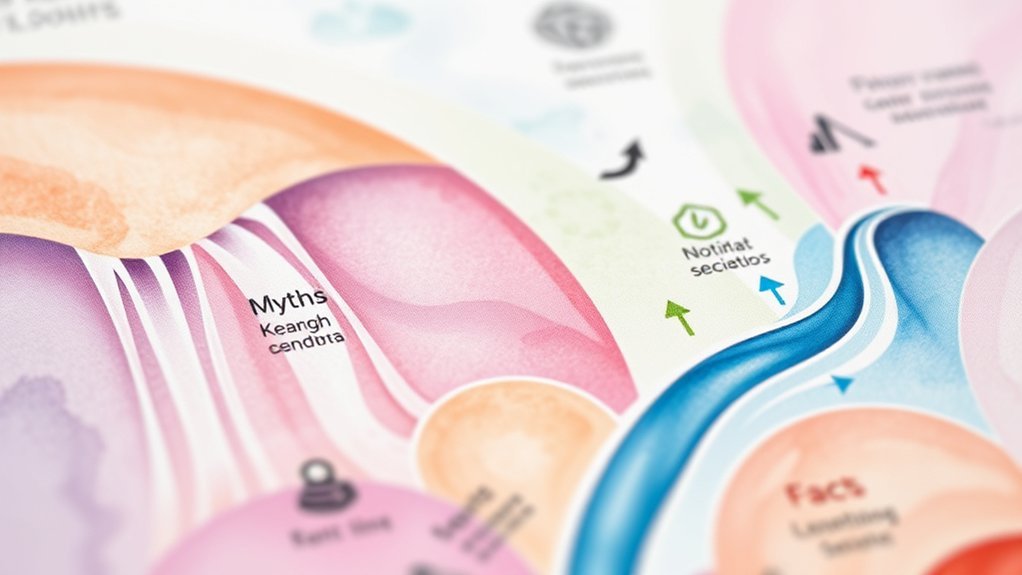Understanding lochia is essential for new mothers as it plays a vital role in postpartum recovery. Many misconceptions surround its stages, from its odor to its duration. For instance, you might think lochia is only present after vaginal deliveries or that it lasts just a week. However, the reality is often different. Knowing the facts can help you monitor your recovery effectively and identify potential complications. Let’s explore these myths further.
Understanding Lochia: What It Is and Its Stages
Understanding Lochia is essential for new mothers as it reflects the body’s recovery process after childbirth.
Lochia is the vaginal discharge experienced in the postpartum period, consisting of blood, uterine lining tissue, and mucus, typically lasting four to six weeks.
It progresses through three stages:
- Lochia Rubra, which appears bright red and lasts 3-4 days, characterized by heavier bleeding and possible small clots;
- Lochia Serosa, which is pinkish-brown and lasts 5-9 days, with a lighter flow;
- Lochia Alba, a yellowish-white discharge lasting up to two weeks, composed mainly of mucus and white blood cells.
Monitoring lochia for abnormal signs, like foul odor or excessive bleeding, is vital, as these may require immediate medical attention.
Common Myths About Lochia
Many new mothers encounter myths surrounding lochia that can lead to unnecessary confusion and anxiety.
One common myth is that lochia should be completely odorless; however, it typically has a stale, musty smell similar to menstrual blood.
Lochia often carries a stale, musty smell, resembling menstrual blood, contrary to the myth of being completely odorless.
Additionally, many believe lochia only occurs after vaginal births, but it happens after both vaginal and cesarean deliveries as part of the healing process.
Some assume postpartum bleeding lasts only a week, but lochia can persist for four to eight weeks.
It’s also a misconception that you can use tampons during the postpartum period; sanitary pads are recommended to reduce infection risk.
Finally, passing blood clots larger than a golf ball may indicate complications needing medical attention.
Recognizing Normal vs. Abnormal Lochia
Recognizing the differences between normal and abnormal lochia is essential for postpartum recovery.
Lochia progresses through three stages: lochia rubra (bright red, lasting 3-4 days), lochia serosa (pinkish-brown, 5-9 days), and lochia alba (yellowish-white, up to 2 weeks).
Normal lochia may include small clots; however, you should seek help if you notice large clots (larger than a golf ball) or if you’re soaking through a pad in less than an hour.
A foul-smelling discharge or persistent bright red bleeding after the first week may indicate infection or retained placenta, necessitating evaluation by a healthcare provider.
Monitoring the color, consistency, and amount of discharge is vital for identifying any abnormal bleeding or complications.
Managing Lochia at Home

After identifying the normal stages of lochia, managing it at home becomes a priority for postpartum recovery.
In the initial days, use heavy-duty sanitary pads, shifting to regular pads as lochia lightens. Avoid tampons for at least six weeks to reduce infection risks.
Monitor the volume and color of lochia, ensuring it changes from bright red (lochia rubra) to pinkish-brown (lochia serosa) and then to yellowish-white (lochia alba). Change pads frequently to maintain hygiene and check for concerning symptoms like large clots or foul-smelling discharge, which may signal complications.
Rest as much as possible, as increased activity can elevate lochia flow. Stay alert for any symptoms requiring medical attention, like soaking a pad in under an hour or severe cramping.
Importance of Seeking Medical Attention
While managing postpartum recovery at home is essential, knowing when to seek medical attention is equally critical for your health. Be vigilant about any signs that could indicate complications.
| Symptom | Action Required |
|---|---|
| Excessive postpartum bleeding | Consult a healthcare provider |
| Large blood clots (golf ball size) | Seek immediate medical attention |
| Foul-smelling discharge | Get evaluated for infection |
| Severe cramping, dizziness, rapid heartbeat | Urgent consultation needed |
| Persistent bright red lochia or sudden increase in bleeding | Schedule a doctor’s assessment |
Recognizing these symptoms early can prevent serious health issues. Always prioritize your well-being and don’t hesitate to reach out for medical support. Accessing comprehensive care during your postpartum period can significantly improve your recovery experience.
Frequently Asked Questions
What Are the Red Flags of Lochia?
Look for red flags like excessive bleeding, large blood clots, sudden increases in bleeding, foul-smelling discharge, or signs of infection. If you experience dizziness or rapid heartbeat, seek medical attention immediately.
Does Every Woman Get Lochia After Birth?
Yes, nearly every woman experiences lochia after birth. It’s a normal part of postpartum recovery, involving the shedding of uterine lining and tissue. Monitor your flow for any unusual changes or symptoms during this healing process.
What Are the Different Stages of Lochia?
You experience three stages of lochia: Lochia Rubra, bright red for 3-4 days; Lochia Serosa, pinkish-brown for 4-10 days; and Lochia Alba, yellowish-white lasting up to 6 weeks, aiding postpartum recovery.
Can I Get Pregnant While Seeing Lochia?
Yes, you can get pregnant while experiencing lochia. Ovulation might occur as early as two weeks postpartum, so relying on lochia as a contraceptive method isn’t safe. Consult your healthcare provider for effective options.
Conclusion
In conclusion, understanding lochia is vital for your postpartum recovery. Did you know that about 80% of women experience lochia for four to six weeks? Recognizing the normal stages and distinguishing them from potential complications can greatly impact your health. By managing lochia properly at home and seeking medical attention when necessary, you can guarantee a smoother recovery. Stay informed, and don’t hesitate to reach out to your healthcare provider with any concerns about your postpartum experience.
